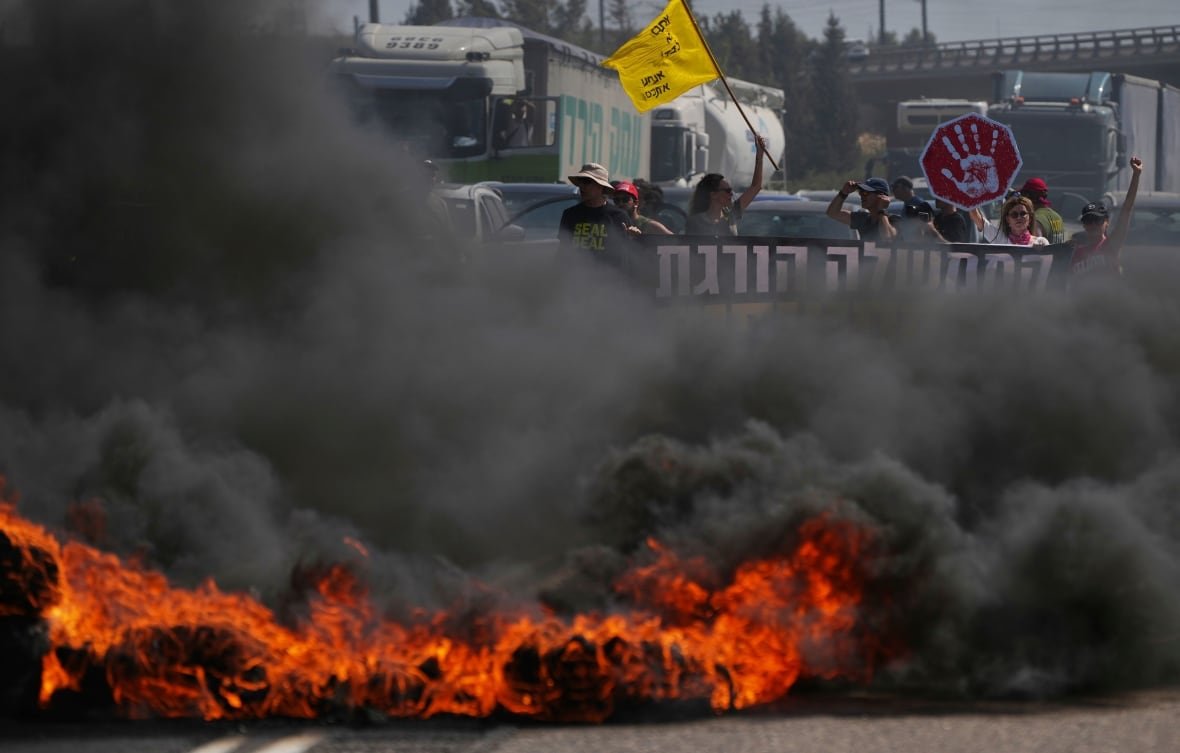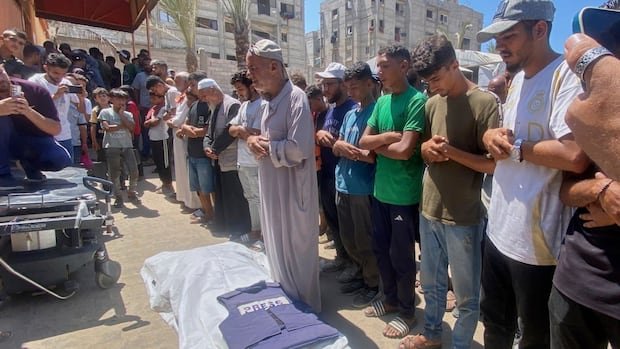A double-strike by Israel that killed five journalists at a hospital in the Gaza Strip has sparked a wave of outrage across the globe, with calls growing for Israel to be held accountable for skyrocketing deaths of members of the press.
On Monday morning, an Israeli strike hit the upper floor of Khan Younis’s Nasser Hospital, in southern Gaza. The Reuters news agency said one of its reporters who was operating a live feed of the area, Hussam Al-Masri, was killed in this strike.
After journalists and rescue workers rushed up an external staircase to the scene of the first strike, a second strike hit the staircase itself — an attack captured by multiple news outlets.
At least 20 people were killed in total, most in the second strike, including five journalists who reported for outlets such as The Associated Press, Al Jazeera, Reuters and the Middle East Eye.
“Attacks on journalists are attacks on the fundamental right to freedom of expression. At a time when reliable information is key, protecting press freedom is more important than ever,” the United Nations wrote in a statement.
“Journalists — including those who risk their lives to expose hard truths — are #NotATarget.”
Israeli Prime Minister Benjamin Netanyahu’s office called the strike a “tragic mishap” and said the military was investigating, without elaborating further.
The double-strike received swift international condemnation. In a post on X, Canada called the attack “unacceptable,” adding that “Israel has the obligation to protect civilians, including journalists and healthcare workers, operating in Gaza.”
The EU has also condemned the attack, with Commission spokesperson Anouar El Anouni stating at a press briefing on Tuesday that “civilians and journalists must be protected under international law.”
At least 197 media workers and reporters have been killed in the war since October 2023, according to the Committee to Protect Journalists, making it one of the deadliest conflicts in history for journalists. The majority have been Palestinian journalists killed in Gaza. Some other monitoring groups have put the figure of journalists killed at more than 200.
“Israel’s broadcasted killing of journalists in Gaza continues while the world watches and fails to act firmly on the most horrific attacks the press has ever faced in recent history,” said Sara Qudah, regional director for the Committee to Protect Journalists, in a statement. “These murders must end now. The perpetrators must no longer be allowed to act with impunity.”
Reporters from different outlets were known to use Nasser Hospital to set up live TV segments. One of the journalists killed, 33-year-old Mariam Dagga, was a visual journalist who had recently reported for the Associated Press on doctors in the hospital struggling to save starving children.
CBC freelance videographer Mohamed El Saife was on the ground in Gaza when two Israeli airstrikes hit Nasser Hospital. At least 20 people are dead, including five journalists.
The strikes on Nasser Hospital came just two weeks after Israel deliberately issued an airstrike on a tent near Al Shifa Hospital to kill Al Jazeera correspondent Anas al-Sharif. Six journalists, including four from Al Jazeera, were killed in the attack.
The Israeli military acknowledged that al-Sharif was the target, but cited intelligence that said he was part of Hamas. CBC News has not seen any intelligence documents that verify this allegation, and Al Jazeera has said the claim is baseless, calling the strike a “targeted assassination.”
As foreign media has been barred by Israel from entering Gaza independently, local journalists doing freelance work have provided the majority of coverage for international media. But deteriorating conditions on the ground have left reporters struggling with the same famine facing civilians.
In July, multiple news outlets, including CBC News, Reuters and the BBC, released a joint statement decrying the “staggering” death toll of journalists in the region and calling on Israel to permit international journalists to enter the enclave.
“As local reporters are killed, face the threat of starvation, or try to flee, the world will be systematically cut off from witnessing what is happening. This cannot be allowed to happen,” the statement reads.
Under international law, health-care facilities and journalists are not supposed to be targeted during armed conflicts.
Journalists and media organizations operating in Gaza have previously raised concerns that Israel is targeting journalists deliberately. Israel has maintained that it tries to mitigate civilian casualties, and has blamed its strikes on health-care facilities on Hamas, alleging the militant group has used such facilities as staging grounds.
A day after the double-strike at Nasser Hospital, Israeli strikes killed at least 16 Palestinians on Tuesday, hospitals said.
Officials from Shifa Hospital, Nasser Hospital and Gaza City’s Sheikh Radwan clinic reported that among the 16 were families, women and children.
Israel’s military offensive has killed more than 62,000 over the past two years, according to Gaza’s Health Ministry, which says around half of those killed have been women and children.
Protests in Israel
Meanwhile, protesters in Israel on Tuesday torched tires, blocked highways and clamoured for a ceasefire that would free hostages still in Gaza, as Israeli leaders pressed ahead with plans for an offensive that they argue is needed to crush Hamas.

Netanyahu is expected to hold a security cabinet meeting later on Tuesday, but it’s unclear if he will discuss ceasefire efforts. He has said that Israel will launch an expanded offensive in Gaza City while simultaneously pursuing a ceasefire, though Israel has yet to send a negotiating team to discuss a proposal on the table.
Netanyahu has said the offensive is the best way to weaken Hamas and return hostages, but hostage families and their supporters have pushed back.
The vast majority of the 251 hostages captured by Hamas on Oct. 7, 2023, have been released during ceasefires. Israel has only rescued eight hostages alive. Fifty hostages remain in Gaza, and around 20 of them are believed by Israel to still be living.

